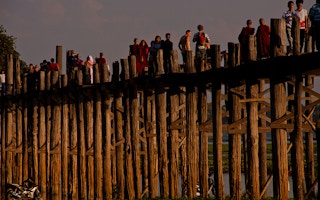The Environmental Investigation Agency (EIA) released allegations Tuesday about what it says is the illegal importation of Burmese teak from Myanmar to the EU.
In a two-month undercover investigation, staff from EIA, a UK-based campaigning organisation, posed as prospective buyers and approached nine importers working in five EU countries.
In a brief, the organisation reports that companies consistently failed to pinpoint the source of the teak they were importing, a tropical hardwood used to make furniture and to build ships.
Several companies call the allegations unfounded, and argued that they cannot be held accountable for problems in a supply chain controlled by the Myanmar government.
Only in 2012 did the EU lift a ban on timber exported from Myanmar. EIA applauded the government in August when leaders imposed a moratorium on all logging until March 2017 to allow the country’s forests to recover. That means that all wood currently moving from Myanmar to international markets must come from existing stockpiles.
The step of following the trail back from where a batch of timber is purchased to where it was harvested is just one aspect of the “due diligence” required of EU companies to comply with the EU Timber Regulation (EUTR), according to EIA. The EUTR is a set of laws intended to stop the flow of illegal wood into the EU that came into full effect in 2013.
“
We have no control over what the MTE offers for sale. We must assume that they are from the area they say and that they are legally cut.
Company agent, Teak Solutions
According to the investigation, businesses operating in the Netherlands, Italy, Belgium, Denmark and Germany have failed to meet this obligation, but EIA forests campaigner Peter Cooper said that the problems don’t stop there.
“It’s not just these nine companies,” said Cooper in an interview with Mongabay. He cited a 2013 WWF report that found that 85 per cent of timber leaving Myanmar should be considered illegal.
The EUTR requires that companies doing business with “high risk” countries that have systemic issues affecting their logging industries make sure that they are buying from legitimate sources.
EIA did acknowledge that the importers they met with appeared to be trying to follow the rules, but that they had stopped short of looking further upstream in the supply chain than the chokepoint at which the Myanmar Timber Enterprise (MTE) controls all timber for export.
The importers argued that this type of upstream investigation in Myanmar just isn’t possible, or appropriate.
“The MTE (Myanmar Timber Enterprise) does not allow anybody to go back to the forest to control,” a representative from the Danish firm Keflico told an EIA staff member posing as a potential client.
In August Keflico “admitted to EIA that it is aware the Myanmar Timber Enterprise is providing it with parcels of teak claimed to originate from a single location when in fact these comprise logs from multiple areas with fake origin documents,” according to the EIA release.
An agent of another company, Teak Solutions, told EIA, “We have no control over what the MTE offers for sale. We must assume that they are from the area they say and that they are legally cut.”
The MTE did not respond to emails from Mongabay requesting comment.
Peter Tsounis, the CEO of Crown-Teak, a company listed in the EIA report, said his company makes sure that all of the wood they purchase comes from the MTE or their authorised concessionaires. If there are inconsistencies in the certification process for the country’s timber, those issues should be sorted out at the government-to-government level, between the EU and Myanmar, Tsounis told Mongabay in an email.
For a private business to circumvent the Myanmar government and carry out their own investigations in the field would be “unlawful” and dangerous, he said.
Crown Teak is a small Belgian firm that provides teak for “high-end” use in building cruise ships, yachts and resorts, Tsounis said. Despite their limited resources, he said, they make monthly visits to sawmills in Asia to verify that all of the documentation is legally in order and that the logs they buy have been properly marked and graded.
“Our due-diligence procedures are quite strenuous and our abiding with the EUTR…is strict,” Tsounis said. “There has not been one single container of teak…that has not been controlled by us and been properly and legally documented.”
Gold Teak Holdings, another company mentioned by EIA that provides teak to the Dutch market, insists that they obtain proper legal certification in the form of a “green book,” which includes export documentation from the Myanmar Forest Products Merchant Federation and certifies that the timber had been legally procured.
“The whole [chain] of custody is mentioned in there,” wrote the managing director of Gold Teak Holdings in an email to Mongabay. “We clearly [determine] the source of our Burmese teak.”
But EIA contends that these companies still aren’t doing enough, and the evidence they have gathered calls into question all teak from Myanmar.
“In simple terms, no teak from Myanmar can legally be placed on the EU market due to the high risk of illegality associated with timber from that country and the lack of transparency by its Government to allow access to information that might demonstrate compliance,” Cooper said in a press release from the EIA.
This story was published with permission from Mongabay.com

















